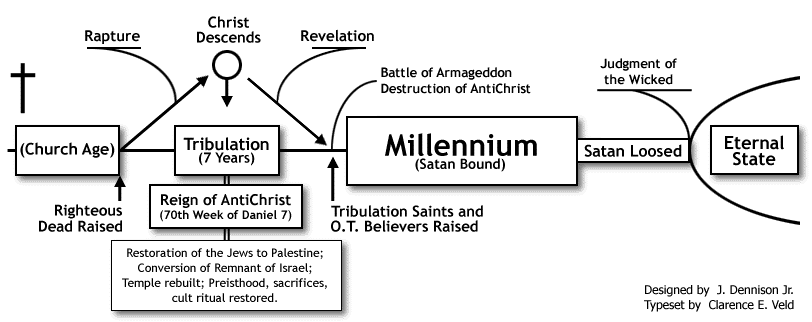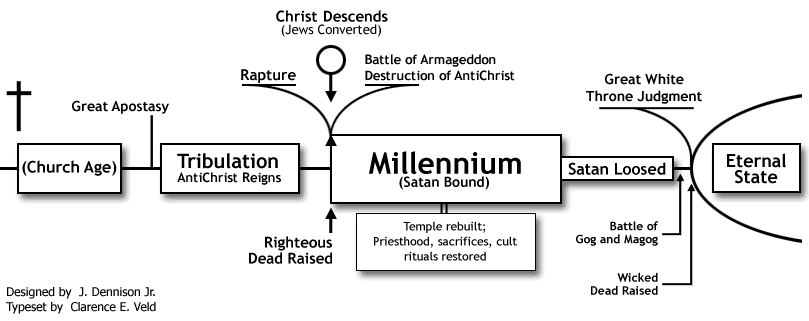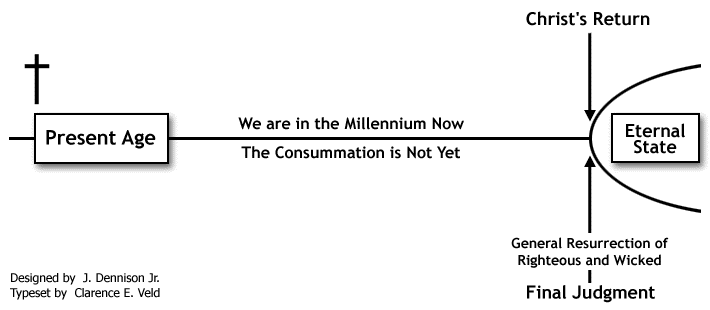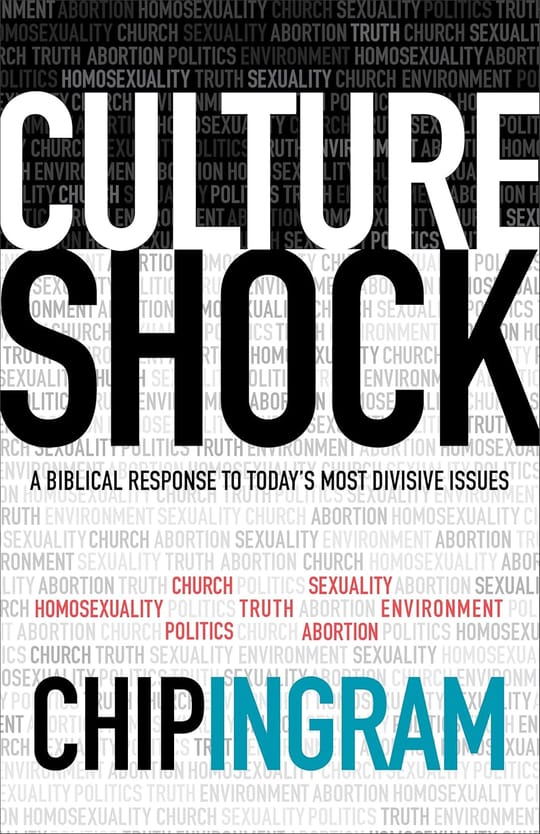Quick summary: While the three main views of the end times differ, they all end similarly: Christ Wins.
In Christian theology, eschatology refers to the study of the “last things” or the end times, focusing on the return of Christ, the final judgment, and the ultimate destiny of humanity. There are several views within Christian eschatology, but the top three are:
1- Premillennialism.
Overview: Premillennialism holds that Christ will return before a literal 1,000-year reign, known as the Millennium. This view is often associated with a literal interpretation of the Book of Revelation.
Key Beliefs:
- Second Coming: Jesus will return physically to earth before the Millennium to establish His kingdom.
- Rapture (Dispensational Premillennialism): Some premillennialists, particularly dispensationalists, believe in a “rapture” where believers will be taken up to meet Christ in the air before a period of tribulation on earth.
- Tribulation: A period of great suffering and persecution precedes Christ’s return, culminating in the Battle of Armageddon.
- Millennium: Christ will reign on earth for 1,000 years, during which time Satan is bound, and there is peace and righteousness.
- Final Judgment: After the Millennium, Satan will be released briefly, leading to a final rebellion, which will be crushed, followed by the final judgment and the establishment of the new heaven and new earth.
Variants: Historic Premillennialism does not typically emphasize the rapture as dispensational premillennialism does. They tend to focus on the second coming of Christ and the rapture as a singular event.
Bibliography:
Dispensational:
- Pentecost, J. Dwight. Things to Come. Grand Rapids: Zondervan Publishing House, 1978. (ISBN 0310308909)
- Ryrie, Charles. The Basis for Premillennial Faith. New York: The Loizeaux Brothers, 1953. (ISBN 0872137414)
- Walvoord, John. Every Prophecy of the Bible. Colorado Springs: Chariot Victor Publishing, 1999. (ISBN 1-56476-758-2)
- Walvoord, John. The Revelation of Jesus Christ. Chicago: Moody Press, 1966. (ISBN 0-8024-7310-5)
- Blaising, Craig A. "Premillennialism." Three Views of the Millennium and Beyond. Ed. Darrell L. Bock. Grand Rapids: Zondervan Publishing House,1999. (ISBN 0-310-20143-8)
Historical:
- Ladd, George Eldon. A Commentary on the Revelation. Grand Rapids: William B. Eerdmans Publishing Company, 1972. (ISBN:0802816843)
- Ladd, George Eldon. The Last Things: An Eschatology for Laymen. Grand Rapids: William B. Eerdmans Publishing Company,1982.
- Ladd, George Eldon. The Gospel of the Kingdom. Grand Rapids: William B. Eerdmans Publishing Company, 1959. (ISBN: 0802812805)
- Culver, Robert Duncan. Histories &Prophecies of Daniel. Winona Lake, Indiana: BHM Books, 1980. (ISBN: 0-88469-131-4)
- Campbell, Donald K. and Townsend, Jeffrey L. A Case for Premillennialism: A New Consensus. Chicago: The Moody Press, 1992.
Dispensational:

Historical:

2- Amillennialism
Overview: Amillennialism interprets the Millennium symbolically rather than literally, viewing it as the current reign of Christ in heaven and through His Church. The “millennium” is not a future 1,000-year but represents the entire church age between Christ’s first and second coming.
Key Beliefs:
- No Literal Millennium: The 1,000 years in Revelation 20 are understood as a symbolic period representing the current reign of Christ, not a literal future event.
- Christ’s Reign: Christ is currently reigning in heaven and in the hearts of believers. His kingdom is both present now and will be fully realized at His return.
- Tribulation: The Church will experience ongoing tribulation and persecution throughout this age, with no distinct future period of tribulation.
- Second Coming: Christ will return at the end of the age to judge the living and the dead, bringing final judgment and the renewal of all things.
- New Heaven and Earth: The current world will be transformed into the new heaven and new earth, where God will dwell with His people eternally.
Emphasis: Amillennialism focuses on the already/not yet tension of God’s kingdom, where Christ’s victory is already achieved but not yet fully consummated.
Bibliography:
- Hoekema, Anthony. The Bible and the Future. Grand Rapids: William B. Eerdmans Publishing Company, 1994. (ISBN: 0802808514)
- Vos, Geerhardus. The Pauline Eschatology. Grand Rapids: William B. Eerdmans Publishing Company, 1953.
- Vos, Geerhardus. Biblical Theology. Grand Rapids: William B. Eerdmans Publishing Company, 1953.
- Ridderbos, Herman. The Coming of the Kingdom. Philadelphia: Presbyterian &Reformed Publishing Company, 1962. (ISBN: 0-87552-408-7)
- Hendrikson, William. More Than Conquerors: An Interpretation of the Book of Revelation. Grand Rapids: Baker Books-, 1939. (ISBN: 0801057922)
- Beale, G.K. The Book of Revelation: A Commentary on the Greek Text. Grand Rapids: William B. Eerdmans Publishing Company, 1999. (ISBN: 0-8028-2174-X)
- Strimple, Robert B. "Amillennialism." Three Views of the Millennium and Beyond. Ed. Darrell L. Bock. Grand Rapids: Zondervan Publishing House,1999. (ISBN 0-310-20143-8)

3- Postmillennialism
Overview: Postmillennialism teaches that Christ will return after the Millennium, a golden age of Christian influence and peace on earth brought about by the spread of the gospel and the transformation of society.
Key Beliefs:
- Optimistic View: The gospel will gradually spread and transform the world, leading to a long period of peace, righteousness, and prosperity, often called the Millennium.
- Christ’s Reign: Christ’s reign is spiritual and mediated through the Church, which will have increasing global influence, culminating in a Christianized society.
- Tribulation: Any tribulation is seen as part of history’s challenges, not as a distinct future period.
- Second Coming: Christ will return at the end of the Millennium to judge the world, resurrect the dead, and bring about the final state.
- Final Judgment: Christ's return brings about the final judgment, the defeat of evil, and the establishment of the new heaven and new earth.
Focus: Postmillennialism is often associated with a strong emphasis on Christian social and cultural engagement, believing that the Church will succeed in spreading the gospel globally before Christ’s return.
Bibliography:
- Murray, Iain H. Puritan Hope. The Banner of Truth Trust, 1996. (ISBN: 085151247X)
- Kik, J. Marcellus. Eschatology of Victory. Nutley: Presbyterian &Reformed Publishing, 1974. (ISBN: 0875523137)
- Gentry Jr., Kenneth L. He Shall Have Dominion: An Eschatology of Victory. Institute for Christian Economics, 1992 (ISBN 0930464621)
- Boettner, Loraine. Millennium. Presbyterian Reformed Publishing Company, 1992. (ISBN: 0875521134)
- Mathison, Keith A. Postmillennialism: An Eschatology of Hope. Presbyterian &Reformed Publishing Company, 1999 (ISBN: 0875523897)
- Gentry Jr., Kenneth L. "Postmillennialism." Three Views of the Millennium and Beyond. Ed. Darrell L. Bock. Grand Rapids: Zondervan Publishing House,1999. (ISBN 0-310-20143-8)

What do these three main views have in common?
Premillennialism, Amillennialism, and Postmillennialism, despite their differences in interpreting the end times, share several important similarities rooted in Christian eschatology. These commonalities reflect core Christian beliefs about the future. Here are the key similarities:
- Belief in the Second Coming of Christ. All three views affirm that Jesus Christ will return to earth. This return is central to their eschatological understanding, even though they differ on when and how it will happen. Each view anticipates a physical, visible return of Christ in glory.
- Final Judgment. All three views agree on a final judgment in which God will judge all people. This judgment will determine the eternal destiny of every person, separating the righteous from the wicked. In each eschatological framework, it is a key event that follows the Second Coming of Christ.
- Resurrection of the Dead. All three views affirm the resurrection of the dead. The righteous and the wicked will be raised to life, with the righteous receiving eternal life and the wicked facing eternal punishment. This resurrection is closely tied to the final judgment.
- New Heaven and New Earth. All three views believe in a new heaven and new earth. After the final judgment, God will create a renewed and perfected world where believers will dwell with Him forever. This new creation will be free from sin, suffering, and death.
- Sovereignty of God. All three views emphasize God’s sovereignty over history. Despite their differences in interpreting the end times, each view agrees that God is in complete control of history and that His plans will be fulfilled according to His divine purpose.
- The Defeat of Evil. All three views agree that evil will ultimately be defeated. Satan, sin, and death will be conquered completely, and righteousness will prevail. The final defeat of evil is a shared hope across these eschatological perspectives.
- Eternal State. All three views believe in eternal existence after the final judgment. Believers will enjoy eternal life in the presence of God, while unbelievers will face eternal separation from God.
- Scriptural Basis. All three views are rooted in a commitment to the authority of Scripture. While they interpret key biblical passages differently (especially those in Revelation, Daniel, and other prophetic books), they are developed from a desire to understand and apply biblical teaching about the end times.
- Role of the Church. All three views see the Church as significant in God’s redemptive plan. Whether viewed as reigning with Christ now (Amillennialism), bringing in the Millennium through the spread of the gospel (Postmillennialism), or awaiting a future reign (Premillennialism), the Church is seen as central to God’s purposes.
- Ultimate Victory of Christ. All three views affirm Christ's ultimate victory over all powers and authorities. Whether this victory occurs before, during, or after the Millennium, each view agrees that Christ will triumph completely and eternally.
While Premillennialism, Amillennialism, and Postmillennialism differ in their interpretations of the Millennium and the sequence of end-time events, they share a foundational belief in the key aspects of Christian eschatology: Christ’s return, final judgment, resurrection, defeat of evil, and the establishment of a new heaven and new earth. These shared beliefs underscore the unity of Christian hope in the ultimate fulfillment of God’s redemptive plan.
Summary:
Premillennialism expects Christ’s return before a literal 1,000-year reign.
Amillennialism views the Millennium as symbolic of the current church age.
Postmillennialism believes the world will progressively improve before Christ returns after a golden age of Christian influence.
Each of these views interprets key biblical passages about the end times differently, leading to varying expectations about the nature and timing of Christ’s return and the final events of history.









